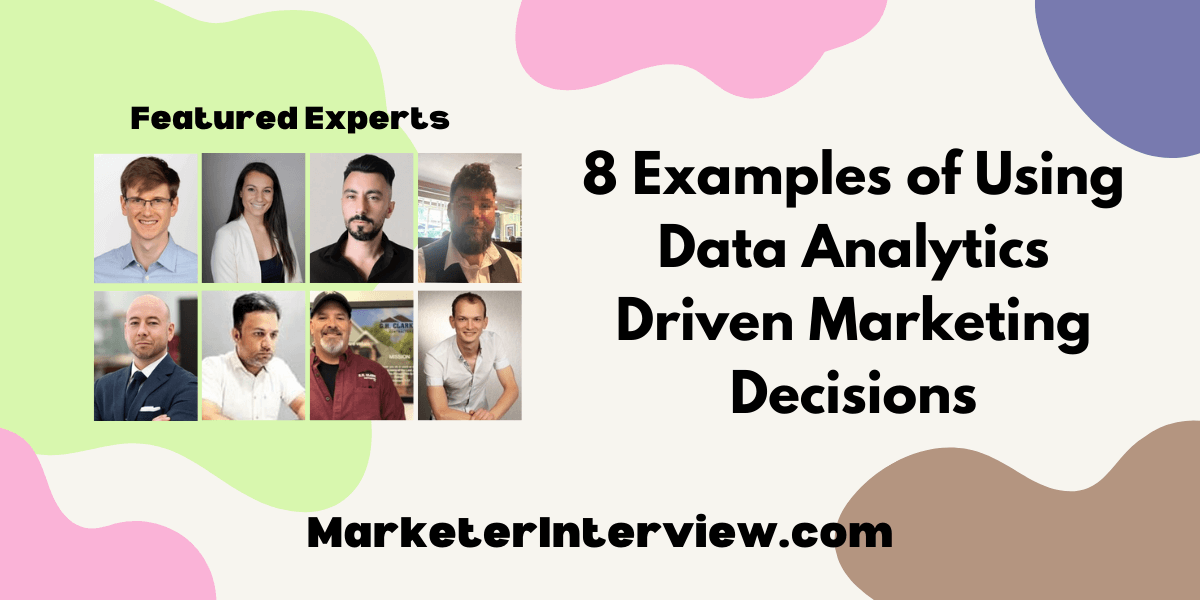8 Examples of Using Data Analytics Driven Marketing Decisions
In the dynamic world of marketing, Data analytics driven is crucial for making informed decisions. We gathered insights from marketing managers to CEOs, detailing how they’ve harnessed the power of data to steer their strategies. From optimizing marketing attribution models to shifting strategy with SEO data analysis, explore the eight specific examples these professionals shared, revealing the impactful results of data-driven marketing.
Want to get quoted in MarketerInterview.com content just like this? Apply to become a contributor today!
Contents
- 1 Data Analytics Driven: Optimizing Marketing Attribution Models
- 2 Fine-Tuning Ads Through Click Data
- 3 Allocating Resources Based on Sales Data
- 4 Identifying Trends with Google Analytics
- 5 Adjusting to Peak Engagement Times
- 6 Uncovering Niche Markets Boosts Enrollment
- 7 Incorporating a Data-Driven Promotional Strategy
- 8 Shifting Strategy with SEO Data Analysis
Data Analytics Driven: Optimizing Marketing Attribution Models
We’ve used data analytics driven to inform a marketing decision involving marketing attribution. In B2B marketing, attribution models play a crucial role in comprehending the impact of each touchpoint throughout the buyer’s journey.
By carefully analyzing customer interactions across a variety of marketing channels, we gain valuable insights that facilitate the strategic allocation of resources. This data-driven approach empowers us to optimize our marketing mix, ensuring a more effective distribution of resources and, consequently, maximizing the return on investment (ROI).

Olivia Santucci, Marketing Manager, The Owl Solutions
Fine-Tuning Ads Through Click Data
For one of our campaigns, we really put data to work. We were running ads, and some were hitting the mark, while others were not so much. By diving into the data analytics driven, specifically looking at click-through rates, we spotted trends. It became clear that certain ads resonated more with our audience.
Armed with this insight, we fine-tuned the underperforming ads—tweaking who saw them and the messaging. This small shift, guided by hard data, led to a noticeable increase in engagement and a better bang for our buck.

Marco Genaro Palma, Content Marketing Manager, PRLab
Allocating Resources Based on Sales Data
We recently analyzed the sources of all sales calls booked with our team, as well as the close rates by channel, and realized that organic search accounted for a significantly larger percentage of the total than we had originally realized. This led us to allocate more resources for the upcoming year toward the website and SEO, while maintaining our other efforts as well.
The close rate data analytics driven by source proved to be particularly insightful, as there was not as large of a difference between channels as we would have originally predicted. We now have a process in place to keep track of this data continuously, to allow for periodic re-evaluation, and to help us track the success or failure of new efforts.

Grant Hensel, CEO, Nonprofit Megaphone
Identifying Trends with Google Analytics
A specific example of using data analytics driven to inform a marketing decision is assessing where there are drops in metrics compared to the previous year. For example, our marketing team uses Google Analytics to evaluate our website. If the overall traffic to the website is down compared to the previous year, we can use analytics to dig into why it is down.
Which landing pages specifically are down? Are different channels getting more traffic this year than last? Once you can identify the trend, you can easily make decisions on where to go next because the information is available to you.

Aaron Grimes, Industrial Sales, Marketing and Product Manager, TYKMA Electrox
Adjusting to Peak Engagement Times
Analyzing customer engagement and data analytics driven, I identified peak hours for online activity. Shifting our social media posting schedule accordingly, we saw a 21% increase in reach and engagement. This data-driven adjustment enhanced our campaign’s effectiveness, showcasing the impact of analytics on marketing decisions.

Fahad Khan, Digital Marketing Manager, Ubuy India
Uncovering Niche Markets Boosts Enrollment
I vividly recall using data analytics driven decision to uncover an overlooked customer segment that significantly boosted enrollment. By scrutinizing registration patterns in our dance studio, I noticed that women aged 45 and over were signing up at far lower rates, likely due to self-consciousness, as we later realized.
This insight sparked an idea: women-only classes catering to this demographic. I developed a specially-designed curriculum focused on making them feel confident, comfortable, and able to have fun without judgment.
The results spoke for themselves. Our inaugural 45+ women’s class filled up rapidly with a relatively small marketing budget and a super-high conversion rate. The students raved about the experience and signed up for additional courses. This revealed an underserved niche that quadrupled revenue from this previously hesitant segment.
Since then, women-only classes have become a staple offering. The validation and community keep devoted students returning session after session. It just took the right analytics lens and empathy to see overlooked potential and help more people step out of their comfort zone to pursue dance.

Roman Bosque, Founder, Dancelifemap.com
Incorporating a Data-Driven Promotional Strategy
Incorporating data analytics driven into marketing strategies has been pivotal for us. A key example was when we analyzed customer feedback and sales data to inform our promotional strategy. The data revealed a high demand for energy-efficient windows in our region.
Capitalizing on this insight, we focused our marketing on the energy-saving benefits of our window installations. The campaign was a success, leading to a 20% increase in window-related inquiries and a notable uptick in sales. This experience underscored the importance of listening to customer needs and using data to drive marketing decisions. It was a clear demonstration of how data analytics can effectively guide business strategies.

Gil Clark Jr., CEO, GH Clark
Shifting Strategy with SEO Data Analysis
I can attest to the power of data analytics from a recent experience that opened my eyes to SEO and what we were able to learn.
We analyzed our website’s SEO data and discovered a significant uptick in traffic for a particular set of keywords related to a niche product category we had previously overlooked. This insight prompted us to shift our marketing strategy and prioritize this niche, allocating more resources toward it.
The results of data analytics driven have been good so far. By capitalizing on the untapped potential identified through SEO data analytics driven, we saw a substantial increase in website traffic and engagement. This shift allowed us to better align our offerings with customer demand and enhance our overall direction.
This example highlights the pivotal role that data analytics can play in shaping marketing decisions and driving tangible business outcomes.

Aaron Bond, Director of Operations, Bond Rees Ltd.
Want to get quoted in MarketerInterview.com content just like this? Apply to become a contributor today!






